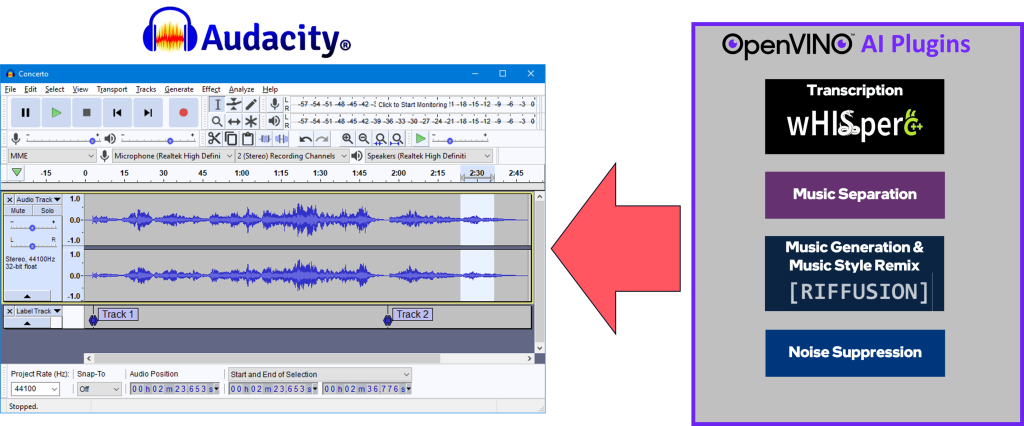Table of Contents
Audacity, the popular open-source audio editing software, has recently introduced some new features that leverage the power of artificial intelligence (AI). These features, developed by Intel, are called “OpenVINO” and they can help audio editors and producers save time and enhance their work.
What are the Audacity AI tools?
The Audacity AI tools are a set of features that run on your PC using your AI-based processors. You don’t need an internet connection to use them, as they work locally on your machine. They are available for download from the OpenVINO GitHub page.
The Audacity AI tools are aimed at two types of Audacity users: podcast editors and music producers. They offer different functionalities for each group, depending on their needs and goals.
How can podcast editors benefit from the Audacity AI tools?
Podcast editors can use the Audacity AI tools to improve the quality and accessibility of their podcasts. One of the features is AI-powered noise suppression, which can reduce the background noise that might interfere with the clarity and professionalism of the podcast. This can be especially useful for podcasters who record in noisy environments or use low-quality microphones.
Another feature is the transcription tool, which can recognize the speech in a sound clip and either transcribe it into text or translate it into another language. This can help podcast editors create subtitles, captions, or transcripts for their podcasts, which can increase their reach and audience engagement. The transcription tool can also help podcast editors edit their podcasts more efficiently, as they can easily search and edit the text instead of listening to the audio repeatedly.
How can music producers benefit from the Audacity AI tools?

Music producers can use the Audacity AI tools to create new and original music or remix existing songs. One of the features is the vocal separation tool, which can isolate the vocals from a song and create an instrumental version of it. This can be useful for music producers who want to use the vocals for another project or create a karaoke version of the song.
Another feature is the non-vocal separation tool, which can split the non-vocal parts of a song into drums, bass, and an “everything else” category. This can help music producers remix or rearrange the song by changing the volume, pitch, or effects of each component.
The most creative feature is the music generation tool, which can produce music from a text-based prompt. For example, you can type in “a happy rock song” or “a sad piano song” and the tool will generate music that matches your description. This can help music producers spark their inspiration or experiment with different genres and moods.
How to use the Audacity AI tools?
To use the Audacity AI tools, you need to have Audacity installed on your PC, along with the OpenVINO toolkit. You can download the OpenVINO toolkit from the OpenVINO GitHub page, where you can also find the installation instructions and the user manual. Once you have installed the OpenVINO toolkit, you can access the Audacity AI tools from the Tools menu in Audacity. You can then select the feature you want to use and follow the steps to apply it to your audio file.
The Audacity AI tools are a great addition to the audio editing software, as they can help you enhance your audio projects with the power of AI. Whether you are a podcast editor or a music producer, you can find a feature that suits your needs and goals. Just make sure you wear your best headphones before you start your audio editing work.





